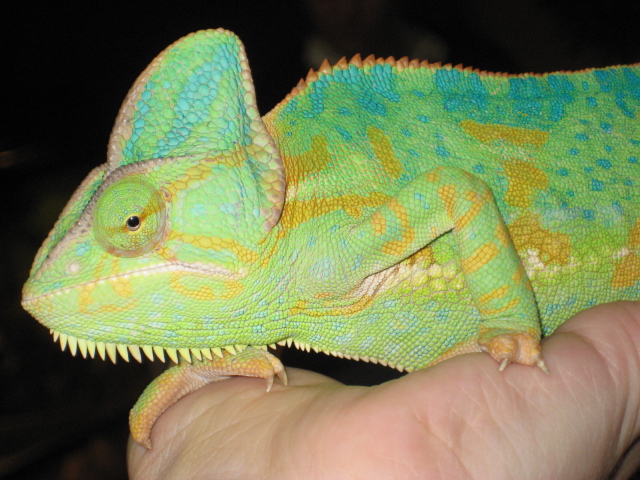

You may also want to dust them with calcium or vitamin supplements.Īs far as veggies, chameleons do best with dark, leafy greens like collard greens and ficus leaves. These bugs have been recently fed, preferably with foods that are high in the types of nutrients that chameleons need. You should try to give them gut-loaded insects as well. They especially like crickets, mealworms, roaches, and waxworms. They need a good variety of insects, so try to give them a few different kinds as often as possible. Related Read: 11 Best Plants for a Chameleon Cage: Top Picks & Reviews.Image Credit: Ondrej Prosicky, Shutterstock The good news is that they don’t require large cages, so it should be easy to give them all the space that they need.
#ADULT TRANSLUCENT VEILED CHAMELEON FULL#
This stress can cause them to not reach their full growth potential, as well as shorten their lifespan. Even assuming that you’re feeding them a healthy diet, putting them in a cage that’s too small can cause them to feel stressed and anxious. The biggest factors determining a chameleon’s size (beyond their species, of course) are their diet and stress level.

Does Cage Size Influence Chameleon Growth?Ī small cage shouldn’t stunt a chameleon’s growth, but it can be an indicator that the lizard is being neglected, and neglect will certainly affect their size. That said, many chameleons will stop growing by the time they’re 9 or 12 months old.įor the most part, chameleons will stop getting longer by the time they’re 8 months old, but they’ll keep putting on weight until they’re 2 years old. The time at which a chameleon will stop growing will depend on the exact species involved, but for the most part, they should be fully grown by 18 months old. Some species will live as long as 10 years in captivity, but it depends on the species and the care that they receive. Sadly, chameleons don’t have long lifespans, so don’t expect yours to live longer than a few years.


Most commercially sold chameleons are less than 2 feet long, however, so don’t worry about having your home taken over by a giant, color-changing lizard. Their coloring may also be dependent on their personalities, as dominant chameleons tend to be brighter than more submissive lizards.Ĭhameleons vary widely in size, with some species (like pygmy chameleons) being quite tiny and others (like the Malagasy giant chameleon) being several feet long. Even within the same species, though, different individuals will sport different colors. The colors that they’ll change to and from will vary depending on the species involved rather than their surroundings. They change their colors for a variety of reasons, including due to their mood, humidity, or changes in light and temperature. However, contrary to popular opinion, chameleons don’t change colors to match their surroundings.
#ADULT TRANSLUCENT VEILED CHAMELEON SKIN#
Chameleons have one big difference, though: they can change their skin color. These are just guidelines, so your lizard may not fall neatly into any of the ranges, but they should be accurate for the vast majority of chameleons.Ĭhameleons are actually part of the iguana suborder, so they’re similar to those common lizards. We put together some charts that will give you an idea of how big four common species of chameleon will be at different life stages as a chameleon’s size and weight largely depend on the specific type. As a result, you may not know whether your chameleon’s growth is normal or if there’s something to be worried about in regard to their development. However, the fact that most people have never owned a chameleon means that first-time owners have little idea of what to expect. They’re always doing something fascinating, yet they’re also fairly low-maintenance, making them ideal pets for just about any animal lover. Chameleons are incredibly interesting creatures, and owning one is a true adventure.


 0 kommentar(er)
0 kommentar(er)
